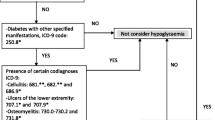Abstract
Background: As lowering glycated hemoglobin (HbA1c) levels is still the main goal of insulin treatment, severe hypoglycemia (SH) remains a common experience in children with Type 1 diabetes mellitus (T1 DM) and their families. Aim: This study aims to evaluate the incidence and the clinical features of SH episodes in our Centre in the last 20 yr. Subjects and Methods: We analyzed SH incidence in 269 patients (pts) diagnosed from 1990 to 2010 (total follow-up 2212.9 pts/yr). Inclusion criteria were at least 3 visits/yr and 1-yr follow-up. SH episode was defined as any condition of low blood glucose requiring third-party assistance. Results: 50.2% of patients experienced at least 1 SH episode for a total of 345 episodes. Whole incidence was 15.6/100 pts/yr, slightly different between first and second decade (12.6 vs 16.5, p=0.047). HbA1c at the time of SH was lower in the non-basal bolus group (7.4±1.3 vs 8.2±1.4; p=0.0001) and worsened 3 months later (p=0.0001). Impaired awareness was the main or only symptom in 43.5%. SH occurred at night in 32% of patients; they were significantly younger than those with SH at other times. Five SH episodes or more occurred in 8.1% of patients who presented a lower HbA1c, a younger age and shorter disease duration than the other patients. HbA1c at first SH was negatively correlated with number of SH (r=−0.20; p=0.05). Conclusions: Despite the advent of new insulin regimens, we confirm that SH still represents a relevant risk and a current threat for patients with T1DM and their families.
Similar content being viewed by others
References
Epidemiology of severe hypoglycemia in the diabetes control and complications trial. The DCCT Research Group. Am J Med 1991, 90: 450–9.
Cryer PE. The barrier of hypoglycemia in diabetes. Diabetes 2008, 57: 3169–76.
The Diabetes Control and Complications Trial/Epidemiology of Diabetes Interventions and Complications (DCCT/EDIC) Study Research Group. Long-term effect of diabetes and its treatment on cognitive function. N Engl J Med 2007, 356: 1842–52.
Skrivarhaug T, Bangstad H-J, Stene LC, Sandvik L, Hanssen KF, Joner G. Long-term mortality in a nationwide cohort of childhood-onset type 1 diabetic patients in Norway. Diabetologia 2006, 49: 298–305.
Clarke W, Jones T, Rewers A, Dunger D, Klingensmith GJ. Assessment and management of hypoglycemia in children and adolescents with diabetes. Pediatric Diabetes 2009, 10(Suppl 12): 134–45.
Alemzadeh R, Berhe T, Wyatt DT. Flexible insulin therapy with glargine insulin improved glycemic control and reduced severe hypoglycemia among preschool-aged children with type 1 diabetes mellitus. Pediatrics 2005, 115: 1320–4.
McCrimmon RJ, Sherwin RS. Hypoglycemia in type 1 diabetes. Diabetes 2010, 59: 2333–9.
Shalitin S, Phillip M. Hypoglycemia in type 1 diabetes. Diabetes Care 2008, 31(Suppl 2): 121–4.
Tamborlane WV. Severe hypoglycemia in youth with T1DM: going, going … but not yet gone. Pediatric Diabetes 2011, 12: 1–3.
Shalitin S, Peter Chase H. Diabetes technology and treatment in the paediatric age group. Int J Clin Pract 2011, 65(Suppl 170): 76–82.
UK Hypoglycaemia Study Group. Risk of hypoglycaemia in types 1 and 2 diabetes: effects of treatment modalities and their duration. Diabetologia 2007, 50: 1140–7.
Tupola S, Rajantie J, Maenpaa J. Severe hypoglycaemia in children and adolescents during multiple dose insulin therapy. Diabet Med 1998, 15: 695–9.
Global IDF/ISPAD Guideline for Diabetes in Childhood and Adolescence, 2011.
Blasetti A, Di Giulio C, Tocco AM, et al. Variables associated with severe hypoglycaemia in children and adolescents with type 1 diabetes: a population-based study. Pediatric Diabetes 2011, 12: 4–10.
O’Connell SM, Cooper MN, Bulsara MK, Davis EA, Jones TW. Reducing rates of severe hypoglycemia in a population-based cohort of children and adolescents with type 1 diabetes over the decade 2000–2009. Diabetes Care 2011, 34: 2379–80.
Rewers A, Chase HP, Mackenzie T, et al. Predictors of acute complications in children with type 1 diabetes. JAMA 2002, 287: 2511–8.
Bulsara MK, Davis EA, Holman DJ, Jones TW. The impact of a decade of changing treatment on rates of severe hypoglycemia in a population-based cohort of children with type 1 diabetes. Diabetes Care 2004, 27: 2293–8.
Diabetes Control and Complications Trial Research Group. Effect of intensive diabetes treatment on the development and progression of long-term complications in adolescents with insulin-dependent diabetes mellitus. Diabetes Control and Complications Trial. J Pediatr 1994, 125: 177–88.
Little S, Shaw J, Home P. Hypoglycemia rates with basal insulin analogs. Diabetes Technol Ther 2011, 13(Suppl 1): S53–64.
Ashwell SG, Amiel SA, Bilous RW, et al. Improved glycaemic control with insulin glargine plus insulin lispro: a multicentre, randomized, cross-over trial in people with Type 1 diabetes. Diabetic Med 2006, 23: 285–92.
Craig ME, Handelsman P, Donaghue KC, et al. Predictors of glycaemic control and hypoglycaemia in children and adolescents with type 1 diabetes from NSW and the ACT. Med J Aust 2002, 177: 235–8.
Brunelle BL, Llewelyn J, Anderson JH jr, Gale EA, Koivisto VA. Meta-analysis of the effect of insulin lispro on severe hypoglycaemia in patients with type 1 diabetes. Diabetes Care 1998, 21: 1726–31.
Cox DJ, Gonder-Frederick L, Ritterband L, Clarke W, Kovatchev BP. Prediction of severe hypoglycemia. Diabetes Care 2007, 30: 1370–3.
White NH, Chase P, Arslanian S, Tamborlane WV, for the 4030 Study Group. Comparison of glycemic variability associated with insulin glargine and intermediate-acting insulin when used as the basal component of multiple daily injections for adolescents with type 1 diabetes. Diabetes Care 2009, 32: 387–93.
Author information
Authors and Affiliations
Corresponding author
Rights and permissions
About this article
Cite this article
Maltoni, G., Zucchini, S., Scipione, M. et al. Severe hypoglycemic episodes: A persistent threat for children with Type 1 diabetes mellitus and their families. J Endocrinol Invest 36, 617–621 (2013). https://doi.org/10.3275/8896
Accepted:
Published:
Issue Date:
DOI: https://doi.org/10.3275/8896



